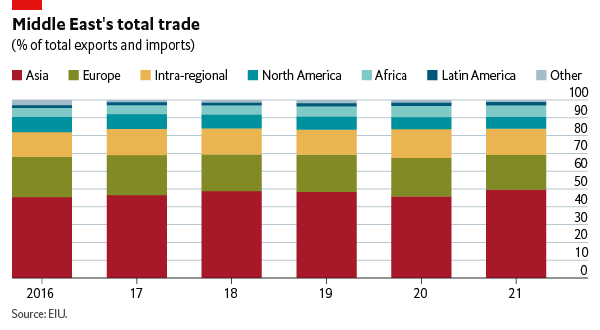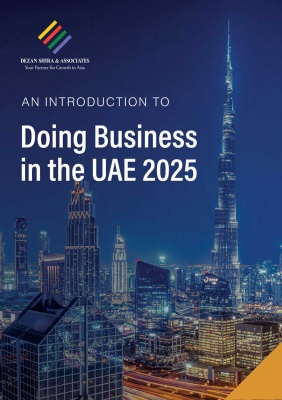The Middle East’s Trade Pivot To East Asia
Regional Trade Is Now Worth US$1 Trillion Per Annum
The Middle and Asia is proving compatible neighbours as the pivot of the Gulf States towards East Asia continues. East Asia especially is now playing a crucial role for the Middle East as a key supplier of exported goods and is the predominant import market for the Middle East’s energy and non-energy goods exports.
A new report by the Economist Intelligence Unit suggests that the trading relationship will get stronger throughout the decade. It also means that for businesses in Europe, cities such as Dubai in particular are now developing as alternative gateways to the East and are competing with Singapore and Hong Kong as regional hubs.
The increasing importance of the trade relationship between the two regions – both technically part of the Asian landmass – is that the Middle East imported US$328 billion worth of goods from Asia (almost 40% of its total imports) and exported US$676 billion worth of goods to Asia in 2021 (almost 60% of its total exports). Total trade with Asia has fully recovered from a slump in 2020—largely caused by the immediate shock of the covid‑19 pandemic—and is hitting new record highs.

Five of the 14 Middle Eastern states had Asia as their largest supplier of imports in 2021, while eight had Asia as their largest export market—including Saudi Arabia, the UAE and Iran, as well as the other energy traders of Iraq, Kuwait, and Qatar. In non-oil trade and services, the picture is similar, with most countries trading the most with Asia—and particularly China, South Korea, Japan and India.
Important dynamics will consolidate Asia’s appeal as a trade and investment partner for the Middle East in the years ahead. Upcoming are free-trade agreements between the Gulf Co-operation Council (GCC) states and China, and others with Japan, South Korea, and India. Negotiations are taking time but have gained momentum and could be finalized either later this year or in 2024, which would provide a major boost to trade and investment ties. The UAE signed off a Closer Economic Partnership Agreement (CEPA) with India last year as a precursor and the immediate results have been a 10% increase in UAE-Indian imports and exports. More can be expected when FTA are signed.
The growing economic clout of China will continue to present some Middle Eastern states—especially the GCC bloc—with the opportunity to diversify their international economic and political relations by “looking East” for new strategic alliances. China will be a major driver of increased trade and investment between the Middle East and Asia in the years ahead.
With a low tax base (9%) and free trade zone options, UAE free trade agreements with China and India means that Western businesses can set up a relevant operation in Dubai and take advantage of the massive consumer markets in these countries without having to get their feet wet in doing so – an arm’s length approach that minimizes risk while investors get a feel for the market.
Related Reading
- Establishing A Foreign Invested Business In Dubai
- An Introduction To Dubai’s Industrial Development Strategy
About Us
Middle East Briefing is one of five regional publications under the Asia Briefing brand. It is supported by Dezan Shira & Associates, a pan-Asia, multi-disciplinary professional services firm that assists foreign investors throughout Asia, including through offices in Dubai (UAE). Dezan Shira & Associates also maintains offices or has alliance partners assisting foreign investors in China, Hong Kong SAR, Indonesia, Singapore, Malaysia, Mongolia, Japan, South Korea, Nepal, The Philippines, Sri Lanka, Thailand, Italy, Germany, Bangladesh, Australia, United States, and United Kingdom and Ireland.
For a complimentary subscription to Middle East Briefing’s content products, please click here. For support with establishing a business in the Middle East or for assistance in analyzing and entering markets elsewhere in Asia, please contact us at dubai@dezshira.com or visit us at www.dezshira.com.
- Previous Article UAE Reaches Global Top Ten In ‘Soft Power’ – Report
- Next Article Clarifying Individual Income Tax Liability In The UAE


